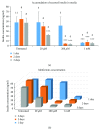Metformin Inhibits Mouse Islet Insulin Secretion and Alters Intracellular Calcium in a Concentration-Dependent and Duration-Dependent Manner near the Circulating Range
- PMID: 29862303
- PMCID: PMC5971297
- DOI: 10.1155/2018/9163052
Metformin Inhibits Mouse Islet Insulin Secretion and Alters Intracellular Calcium in a Concentration-Dependent and Duration-Dependent Manner near the Circulating Range
Abstract
Metformin is considered the first-line treatment for type 2 diabetes. While metformin primarily increases insulin sensitivity, evidence also suggests that metformin affects the activity of insulin-secreting pancreatic islets. This study was designed to systematically examine the direct effects of metformin by measuring insulin secretion and the kinetics of the calcium response to glucose stimulation in isolated mouse islets using varying concentrations (20 μM, 200 μM, and 1 mM) and durations (~1, 2, and 3 days) of metformin exposure. We observed both concentration- and duration-dependent inhibitory effects of metformin. Concentrations as little as 20 μM (nearing circulating therapeutic levels) were sufficient to reduce insulin secretion following 3-day treatment. Concentrations of 200 μM and 1 mM produced more pronounced effects more rapidly. With 1 mM metformin, islets showed severe impairments in calcium handling, inhibition of insulin secretion, and increased cell death. No stimulatory effects of metformin were observed for any experimental endpoint. We conclude that the direct effects of metformin on islets are inhibitory at near-physiological concentrations. Beneficial effects of metformin observed on islets under various stressors may occur by "resting" fatigued cellular processes. However, metformin may have unintended consequences on normally functioning islets within the circulating range that require further evaluation.
Figures





Similar articles
-
Acute and long-term effects of metformin on the function and insulin secretory responsiveness of clonal β-cells.Biol Chem. 2010 Dec;391(12):1451-9. doi: 10.1515/BC.2010.139. Biol Chem. 2010. PMID: 20868233
-
Metformin restores insulin secretion altered by chronic exposure to free fatty acids or high glucose: a direct metformin effect on pancreatic beta-cells.Diabetes. 2000 May;49(5):735-40. doi: 10.2337/diabetes.49.5.735. Diabetes. 2000. PMID: 10905481
-
The biguanide compound metformin prevents desensitization of human pancreatic islets induced by high glucose.Eur J Pharmacol. 1999 Jan 8;364(2-3):205-9. doi: 10.1016/s0014-2999(98)00807-3. Eur J Pharmacol. 1999. PMID: 9932725
-
[Insulin oscillations--clinically important rhythm. Antidiabetics should increase the pulsative component of the insulin release].Lakartidningen. 2007 Aug 8-21;104(32-33):2236-9. Lakartidningen. 2007. PMID: 17822201 Review. Swedish. No abstract available.
-
[Action of metformin in insulin resistance].Journ Annu Diabetol Hotel Dieu. 1985:307-17. Journ Annu Diabetol Hotel Dieu. 1985. PMID: 2577974 Review. French. No abstract available.
Cited by
-
Glucose-responsive Insulinoma with Insulin Hypersecretion Suppressed by Metformin.Intern Med. 2019 Dec 15;58(24):3563-3568. doi: 10.2169/internalmedicine.3318-19. Epub 2019 Aug 28. Intern Med. 2019. PMID: 31462593 Free PMC article.
-
Insulin and the insulin receptor collaborate to promote human gastric cancer.Gastric Cancer. 2022 Jan;25(1):107-123. doi: 10.1007/s10120-021-01236-y. Epub 2021 Sep 23. Gastric Cancer. 2022. PMID: 34554347 Free PMC article.
-
Similarities in Calcium Oscillations Between Neonatal Mouse Islets and Mature Islets Exposed to Chronic Hyperglycemia.Endocrinology. 2022 Jul 1;163(7):bqac066. doi: 10.1210/endocr/bqac066. Endocrinology. 2022. PMID: 35551371 Free PMC article.
-
Chronic stimulation induces adaptive potassium channel activity that restores calcium oscillations in pancreatic islets in vitro.Am J Physiol Endocrinol Metab. 2020 Apr 1;318(4):E554-E563. doi: 10.1152/ajpendo.00482.2019. Epub 2020 Feb 18. Am J Physiol Endocrinol Metab. 2020. PMID: 32069073 Free PMC article.
-
Kinetic and data-driven modeling of pancreatic β-cell central carbon metabolism and insulin secretion.PLoS Comput Biol. 2022 Oct 17;18(10):e1010555. doi: 10.1371/journal.pcbi.1010555. eCollection 2022 Oct. PLoS Comput Biol. 2022. PMID: 36251711 Free PMC article.
References
MeSH terms
Substances
LinkOut - more resources
Full Text Sources
Other Literature Sources
Medical

